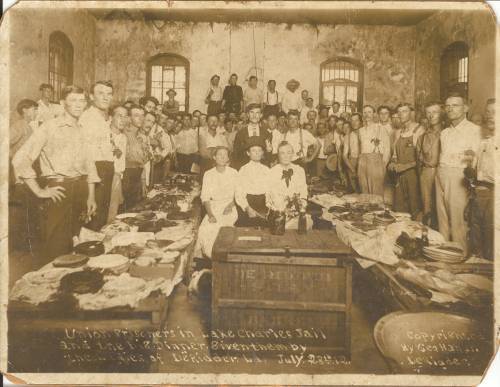Grabow Riot (1912)
Sun Jul 07, 1912

Image: Imprisoned union workers following the Grabow Riot of 7th July, 1912. [libcom.org]
On this day in 1912, a riot broke out in Grabow, Louisiana when gunfire was exchanged between organizing lumber workers and private gunmen hired by the Galloway Lumber Company, just one event in the Louisiana-Texas Lumber War. The clash left three union workers and one company gunman dead, wounding an estimated fifty more.
The event took place in the context of workers in the sawmill town of Grabow joining the Brotherhood of Timber Workers (shown), a branch of the Lumber Workers Industrial Union (LWIU), itself affiliated with the Industrial Workers of the World (IWW).
On July 7th, 1912, the union workers held a series of rallies at several different company towns, including Bon Ami and Carson, alongside Grabow.
The group that went to Grabow, around 200 people, spontaneously decided to hold a rally with several speeches - labor leader Arthur L. Emerson spoke on top of a wagon to roughly 25 non-union men, plus the additional union men who had come with him.
Shots began between these workers and a group of four others, including Galloway Lumber owner John Galloway, in the local mill office, all of whom had later been found to be drinking before the incident. It is not known for certain which group fired first. Three union men were killed alongside one member of the private company security force. Approximately 50 more were wounded.
Over the next few days, more than more than 60 workers were taken into custody by police. Although the mill owner himself was arrested, he was released without charges soon afterward. Sixty-five of the timber workers' group were brought up on charges ranging from inciting a riot to murder.
The IWW worked to aid the incarcerated workers, with "Big Bill" Haywood fundraising for their legal fund. The trial lasted until November 8th, and its jury returned a not guilty verdict for all of the union men. All of those arrested were set free.
Although they had limited success in Louisiana, the LWIU successfully organized later, winning an eight-hour day and vastly improved working conditions in the Pacific Northwest after a 1917 strike. Today, there is a historical marker at the site of the riot, located on what is now the property of DeRidder Airport, Louisiana.
Thanks for the report. It's now updated and reported to apeoplescalendar.org